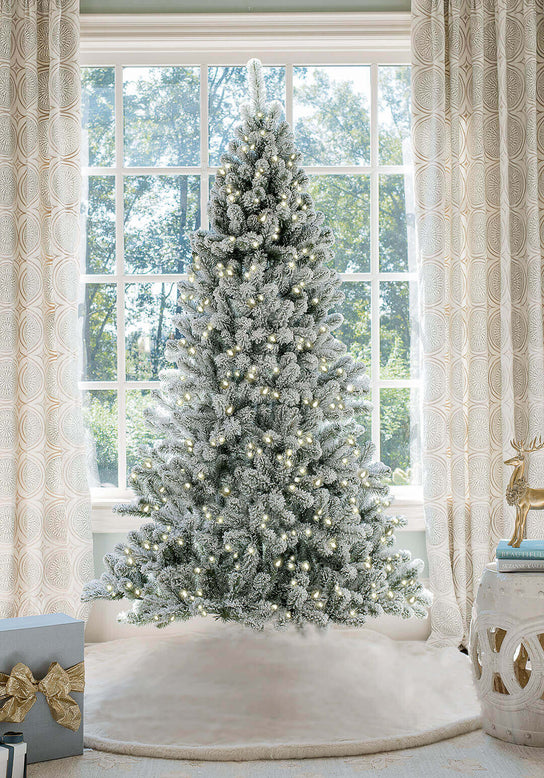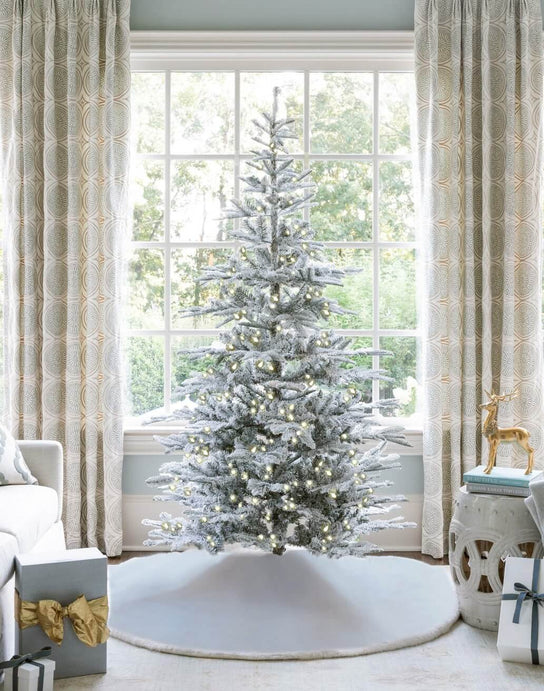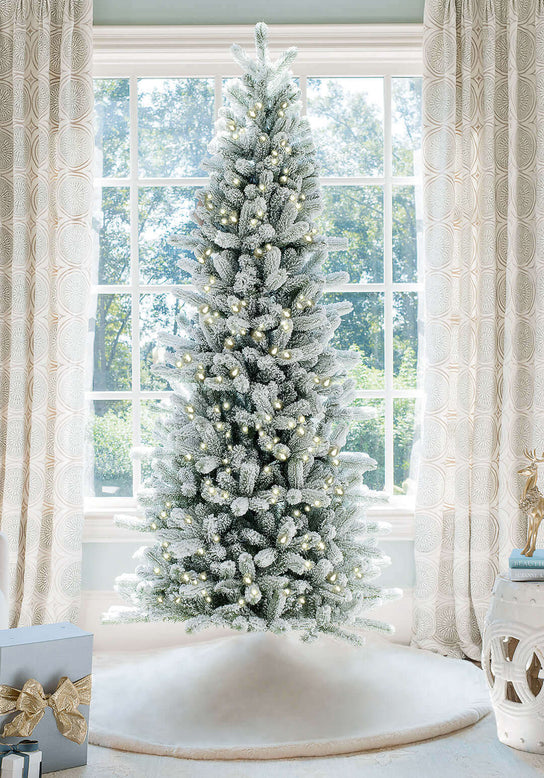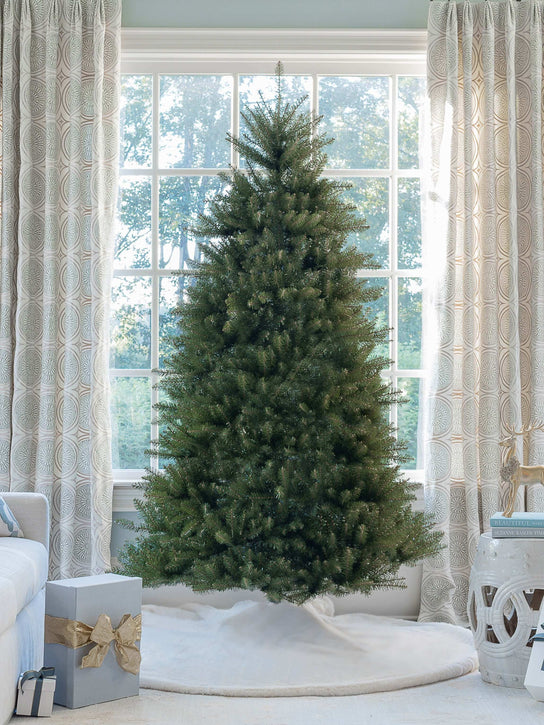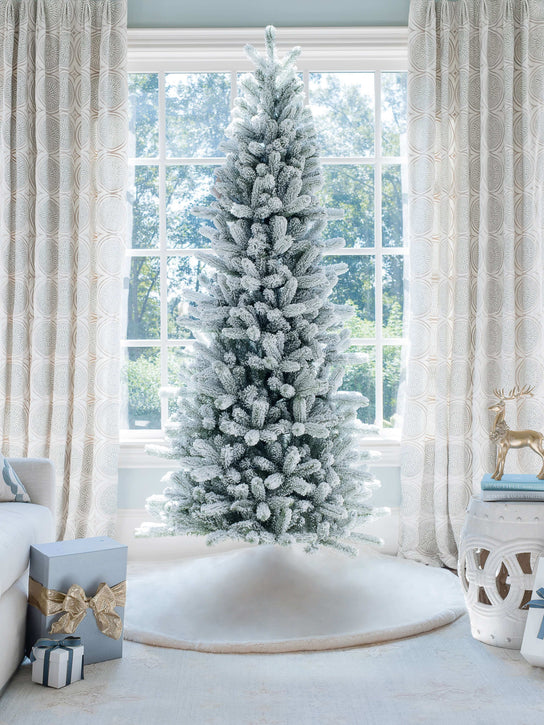When it comes to holiday decorating, your Christmas tree is undeniably the centerpiece of your festive ambiance. Choosing the right artificial Christmas tree can seem daunting with the plethora of options available. But don't fret! While the ultimate choice is yours and comes down to personal preference, we’ve broken down the key considerations to help you find the perfect tree for your home.
Size Matters: Finding the Perfect Fit
Selecting the right size for your artificial Christmas tree is crucial and depends on several factors, including the space you have available, ceiling height, and how much of a statement you want to make. Here’s a simple guide to help you pick the ideal size:
Measure Your Space: Before making any purchase, measure the area where you plan to place the tree. Consider the width and height of the space to ensure your tree will fit comfortably without overwhelming the room.
Ceiling Height: Your tree should be at least 6 to 12 inches shorter than your ceiling height. For instance, if you have an 8-foot ceiling, opt for a tree around 7 feet tall for the perfect fit. This leaves room for a tree topper while ensuring the tree isn't too close to the ceiling.
Proportion: The proportions of the room are just as important as the height. A large tree in a small room can feel cramped, while a small tree in a spacious room might look underwhelming. Aim for a tree that complements the space, adding to its charm rather than overpowering it.
Consider the Base: Don’t forget the tree stand or any additional decorations at the base. Ensure you have enough space for these without crowding the room. A well-balanced tree with a stable stand is essential for safety and aesthetics.
Style: Achieving Your Desired Look

Choosing the right style of artificial Christmas tree largely depends on personal preferences, available space, and the overall aesthetic you want to achieve. Here’s a breakdown of popular styles:
Slim Trees: Slim artificial Christmas trees are ideal for smaller spaces or for those who prefer a minimalist look. With a narrow profile, they fit well in tight corners or narrow rooms. Slim trees are also great for apartments or condos where space is limited. Consider a slim tree if you want to maximize floor space while still enjoying the beauty of a Christmas tree.
Full Trees: Full artificial Christmas trees offer a lush and dense appearance, resembling traditional real trees. They are perfect for those who love classic, abundant holiday decor. Full trees provide plenty of branches for hanging ornaments and decorations, creating a stunning focal point in any room. Choose a full tree if you want a traditional and timeless Christmas tree style.
Wide Trees: Wide artificial Christmas trees have a broader silhouette, offering a more expansive and grand appearance. They are great for large rooms or spaces where you want to make a statement with your holiday decor. Wide trees provide ample space for showcasing a wide array of ornaments and decorations, making them perfect for elaborate and extravagant themes. Consider a wide tree if you have a spacious living room or foyer and want to create a dramatic effect.
Sparse Trees: Sparse artificial Christmas trees have fewer branches and a more open appearance, giving them a unique and rustic charm. They are perfect for those who prefer a more natural and organic look for their holiday decor. Sparse trees allow ornaments and decorations to stand out, creating a visually interesting display. They are also great for showcasing larger ornaments or special keepsakes. Choose a sparse tree if you want to evoke a sense of simplicity and understated elegance.
Realism: Realistic vs. Classic Trees
When it comes to realism, artificial Christmas trees typically fall into two categories: PVC (Polyvinyl Chloride) and PE (Polyethylene). Each material offers a different level of realism and comes with its own set of benefits.

Cost: PVC trees are generally more affordable than PE trees. They are made from strips of PVC
material molded into needles.
Appearance: PVC trees tend to have a more uniform appearance, with branches that may appear more artificial compared to PE trees.
Durability: PVC trees can be durable and long-lasting if cared for properly, though they may be more prone to shedding over time.
Maintenance: PVC trees may require some fluffing and shaping to achieve a fuller appearance, especially after being stored.

Cost: PE trees are typically more expensive than PVC trees due to the higher cost of materials and manufacturing.
Appearance: PE trees are known for their realistic appearance, with needles that closely resemble those of real trees. They have a more natural look and feel compared to PVC trees.
Durability: PE trees are often more durable and resistant to shedding than PVC trees. The branches are made from injection-molded polyethylene, which is more flexible and resilient.
Maintenance: PE trees generally require less fluffing and shaping than PVC trees due to their more natural appearance.
Ultimately, the choice between PVC and PE artificial Christmas trees comes down to your budget, aesthetic preferences, and how important realism is to you. If you prioritize a lifelike appearance and don't mind investing a bit more, a PE tree may be the best option. However, if budget is a concern or you prefer a wider variety of styles, a PVC tree is a great alternative.
Pre-lit or Unlit:
Deciding between a pre lit and unlit artificial Christmas tree depends on your personal preferences, convenience, and desired customization. Here's a comparison to help you make the right choice:

● Uniformity: Prelit trees typically have evenly spaced lights, ensuring a uniform and well-lit appearance without the hassle of stringing lights yourself.
● Variety: Prelit trees come in a variety of lighting options, including clear lights, colored lights, or LED lights with various color and brightness settings.
● Maintenance: With prelit trees, you don't have to worry about replacing or untangling light strands each year, as the lights are integrated into the tree.

● Customization: Unlit trees offer greater flexibility for customization. You can choose your preferred type and color of lights, as well as the density and placement of the lights.
● Versatility: Unlit trees allow you to change the lighting scheme each year or even use different types of decorations, such as garlands or ribbon lights, to achieve your desired look.
● Longevity: Since unlit trees don't have built-in lights, they may have a longer lifespan as there are no electrical components to wear out or malfunction over time.
● Budget: Unlit trees are often less expensive than prelit trees, making them a more budget-friendly option if you already have suitable lights or prefer to purchase them separately.
Consider the following factors when deciding between a prelit and unlit tree:
Time and Effort: Are you willing to spend extra time stringing lights on an unlit tree, or do you prefer the convenience of a prelit tree?
Customization: Do you want the flexibility to customize the lighting scheme and decorations each year, or are you satisfied with the convenience of built-in lights?
Long-Term Use: How important is longevity and durability to you? Will you be using the tree for several years, or do you prefer to replace it more frequently?
Ultimately, both prelit and unlit trees have their advantages, so choose the option that best suits your preferences, lifestyle, and budget.
Budget:
● Set a Budget: Determine how much you're willing to spend on an artificial Christmas tree. Having a clear budget in mind will help you narrow down your options and make a more informed decision.● Consider Long-Term Investment: While it may be tempting to opt for the cheapest option available, consider the long-term investment value of the tree. A higher-quality tree may cost more upfront but could last for many years, saving you money in the long run compared to having to replace a lower-quality tree more frequently.
● Evaluate Materials and Construction: Pay attention to the materials used and the construction quality of the tree. Higher-quality trees are typically made from durable materials such as PVC or PE and feature sturdy metal frames. Look for features like hinged branches for easy assembly and storage.
● Choose Size Wisely: The size of the tree can significantly impact the cost. Consider the available space in your home and opt for a size that fits your needs without exceeding your budget. Remember that smaller trees are usually less expensive than larger ones.

Picking the right artificial Christmas tree is all about finding the one that brings joy to your holiday season. Whether you prefer a slim, full, wide, or sparse tree, and whether you prioritize realism or classic charm, there’s an artificial tree out there that’s perfect for you.
By considering factors such as size, style, realism, and additional features, you’ll be well on your way to selecting a tree that not only fits your space but also enhances your holiday traditions. Remember, the best tree is the one that makes you and your loved ones smile every time you see it.
Happy decorating!







